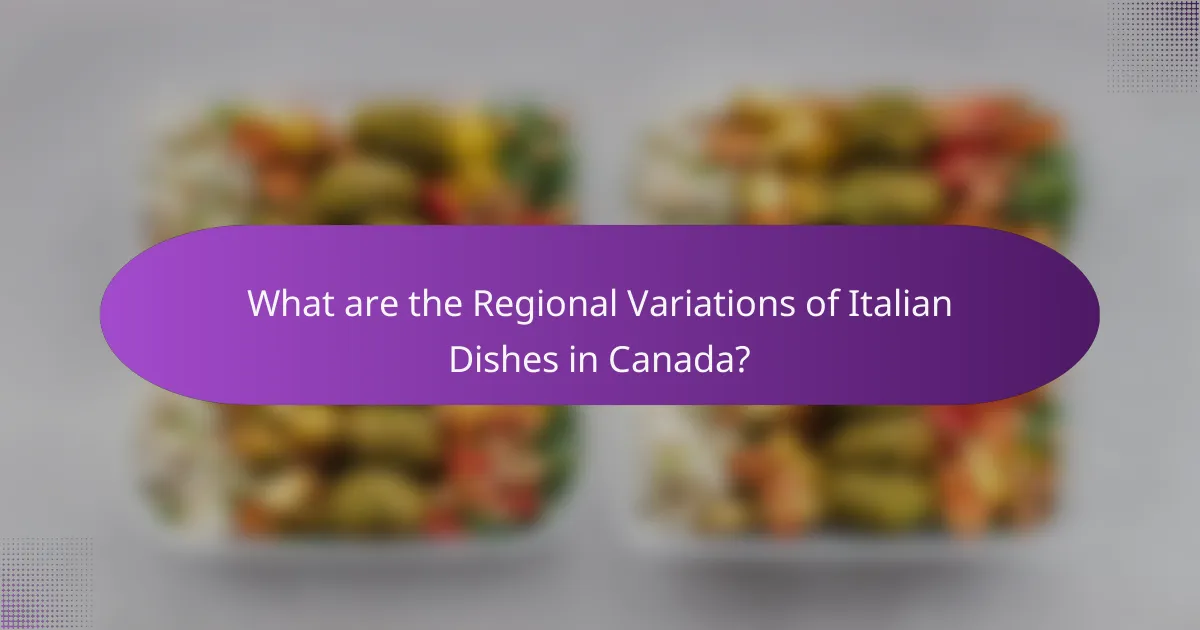
What are the Regional Variations of Italian Dishes in Canada?
Italian dishes in Canada exhibit significant regional variations influenced by local ingredients and cultural preferences. In Quebec, for example, dishes often incorporate local cheeses and meats, resulting in unique interpretations of classic recipes. The use of poutine as a base for Italian-style toppings is a notable fusion. In Ontario, particularly in Toronto, there is a strong presence of Southern Italian cuisine, with an emphasis on Neapolitan-style pizza and pasta dishes. British Columbia showcases fresh seafood in Italian dishes, reflecting its coastal location. Alberta’s Italian cuisine often features hearty meat dishes, influenced by the province’s ranching culture. These regional adaptations highlight the blend of traditional Italian cooking with Canadian culinary practices.
How do regional differences influence the preparation of Italian dishes in Canada?
Regional differences significantly influence the preparation of Italian dishes in Canada. Canadian Italian cuisine reflects the diverse regions of Italy. For example, Northern Italian dishes often feature cream and butter, while Southern Italian recipes emphasize olive oil and tomatoes.
In Canada, Italian communities often adapt recipes to local ingredients. This results in variations such as using Canadian cheeses instead of traditional Italian varieties. Moreover, regional influences from other cultures in Canada shape Italian cooking styles.
For instance, in cities like Toronto, the blend of Italian and local flavors leads to unique fusion dishes. Additionally, availability of ingredients varies by region, affecting traditional recipes. These adaptations illustrate how regional differences create a distinct Canadian Italian culinary identity.
What are the key regions in Canada known for Italian cuisine?
The key regions in Canada known for Italian cuisine are Ontario, Quebec, and British Columbia. Ontario, particularly Toronto, has a vibrant Italian community and numerous authentic restaurants. Quebec, especially Montreal, features a rich blend of Italian and French culinary traditions. British Columbia, with cities like Vancouver, offers a diverse Italian dining scene influenced by local ingredients. These regions host festivals, markets, and events celebrating Italian food culture.
How do local ingredients affect Italian dish variations in different regions?
Local ingredients significantly influence Italian dish variations across different regions. Each region in Italy utilizes ingredients that are abundant and culturally relevant. For example, northern regions often incorporate rice and butter due to their agricultural practices. Conversely, southern regions favor tomatoes and olive oil, reflecting their warmer climate and Mediterranean agriculture.
In Canada, these regional differences are mirrored through local adaptations. Italian communities often use locally sourced ingredients, such as Canadian cheeses or vegetables, to create unique versions of traditional dishes. This practice enhances flavors and connects the dishes to the local culture.
The result is a diverse culinary landscape that honors Italian heritage while embracing regional characteristics. This adaptability allows for a richer gastronomic experience, showcasing both Italian traditions and local Canadian influences.
What are the most popular Italian dishes found across Canada?
Pizza is the most popular Italian dish found across Canada. It is widely available in various styles, including Neapolitan and Chicago deep-dish. Pasta dishes, such as spaghetti and lasagna, are also favorites among Canadians. Risotto is another common dish, often featuring local ingredients. Italian sandwiches, like panini, are popular for quick meals. Italian desserts, especially tiramisu and cannoli, are frequently enjoyed. According to a 2021 survey, pizza ranked as the top choice for Italian cuisine in Canada. This reflects the strong influence of Italian culture in Canadian food preferences.
Which Italian dishes have become staples in Canadian households?
Pasta and pizza are Italian dishes that have become staples in Canadian households. Pasta dishes such as spaghetti and lasagna are widely consumed. Pizza, particularly with various toppings, is a popular choice for many families. These dishes are often served during family gatherings and celebrations. The popularity of Italian cuisine in Canada is reflected in its presence in restaurants and homes. Statistics show that over 60% of Canadians enjoy Italian food regularly. This trend highlights the cultural integration of Italian dishes into Canadian culinary traditions.
How do traditional Italian recipes differ in Canadian adaptations?
Traditional Italian recipes differ in Canadian adaptations primarily through ingredient substitutions and regional influences. Canadian adaptations often use locally available ingredients, which may alter the flavor and texture of the dishes. For example, Canadian versions of pasta sauces may incorporate ingredients like maple syrup or local cheeses not traditionally found in Italy.
Additionally, portion sizes in Canada tend to be larger compared to traditional Italian servings. The cooking methods may also vary, with Canadian adaptations sometimes utilizing grilling or barbecuing techniques more common in North America.
Furthermore, the influence of multiculturalism in Canada leads to the fusion of Italian recipes with other cuisines, creating unique dishes. This is evident in the popularity of items like pizza topped with unconventional ingredients such as butter chicken or poutine.
Overall, while the core elements of Italian cuisine are retained, Canadian adaptations reflect local tastes and cultural diversity.
What cultural influences shape Italian cuisine in Canada?
Italian cuisine in Canada is shaped by various cultural influences, primarily from Italian immigrants. These immigrants brought regional dishes from Italy, including recipes from regions like Sicily and Tuscany. The adaptation of these dishes often reflects local Canadian ingredients and culinary practices.
The integration of Italian cuisine into Canadian culture has led to unique variations, such as the use of local seafood in pasta dishes. Additionally, the influence of multiculturalism in Canada has allowed for fusion with other cuisines.
For example, Canadian Italian restaurants may incorporate elements from Chinese or Indian cooking. This blending creates new flavors and dishes that are distinct to the Canadian context.
Overall, the cultural influences shaping Italian cuisine in Canada are a combination of traditional Italian practices and local Canadian adaptations.
How do immigrant communities impact the evolution of Italian dishes?
Immigrant communities significantly impact the evolution of Italian dishes by introducing new ingredients and cooking techniques. These communities adapt traditional recipes to local tastes and available resources. For example, Italian immigrants in Canada incorporated local produce and meats into their dishes. This led to unique variations such as pizza topped with Canadian bacon or poutine-inspired pasta dishes. Historical migration patterns show that each wave of Italian immigrants brought distinct regional influences. Consequently, dishes like lasagna evolved to include different cheeses and sauces based on regional preferences. This blending of culinary traditions enriches the Italian food landscape in Canada.
What role do festivals and events play in promoting regional Italian dishes?
Festivals and events play a crucial role in promoting regional Italian dishes. They serve as platforms for showcasing local culinary traditions. These gatherings attract both locals and tourists, increasing awareness of regional cuisines. By featuring specific dishes, festivals highlight the unique ingredients and cooking techniques of various Italian regions. Events often include cooking demonstrations and tastings, allowing attendees to experience the flavors firsthand. This experiential learning fosters appreciation for the cultural heritage behind the dishes. Additionally, festivals can boost local economies by supporting restaurants and food vendors. Overall, they enhance visibility and appreciation for regional Italian cuisine.
How does the climate affect the types of Italian dishes served in Canada?
Climate influences the types of Italian dishes served in Canada by affecting ingredient availability and preparation methods. In colder regions, hearty dishes like risottos and stews are more popular. These dishes utilize ingredients that store well, such as root vegetables and grains. Conversely, warmer areas may favor lighter dishes, such as salads and seafood pastas. Seasonal changes also impact menu offerings, with winter featuring rich, warming flavors and summer highlighting fresh, vibrant ingredients. The Canadian climate leads to adaptations in traditional recipes to suit local tastes and available produce.
What seasonal ingredients are commonly used in regional Italian dishes?
Seasonal ingredients commonly used in regional Italian dishes include tomatoes, basil, and zucchini in summer. In autumn, ingredients like mushrooms, chestnuts, and pumpkin are prevalent. Winter brings ingredients such as kale, citrus fruits, and root vegetables. Spring features asparagus, artichokes, and peas. These ingredients reflect the traditional agricultural cycles of Italy. Each region utilizes these seasonal ingredients to create distinct flavors and dishes. For example, the use of fresh tomatoes and basil is essential in southern Italian cuisine. In contrast, northern regions often emphasize heartier ingredients like polenta and mushrooms.
How do weather patterns influence cooking styles in different provinces?
Weather patterns significantly influence cooking styles across different provinces. In warmer provinces, such as British Columbia, outdoor grilling and fresh salads are common. High temperatures encourage the use of seasonal produce and lighter dishes. In contrast, colder provinces like Quebec favor hearty meals, such as stews and casseroles. These dishes provide warmth and comfort during long winters. Additionally, humidity levels can affect the preservation methods used in cooking. For instance, drier climates may lead to more smoking and drying of meats, while humid areas may rely on pickling. Regional ingredients also adapt to local weather, shaping unique culinary traditions. Overall, weather patterns directly impact ingredient availability and cooking techniques.
What are some unique Italian dishes specific to certain Canadian regions?
Unique Italian dishes specific to certain Canadian regions include “Pasta alla Puttanesca” in Toronto and “Tortellini in Brodo” in Winnipeg. Toronto’s diverse Italian community popularized Pasta alla Puttanesca, featuring tomatoes, olives, and capers. This dish reflects the city’s vibrant culinary scene. In Winnipeg, Tortellini in Brodo is a traditional dish served in broth, showcasing the city’s Italian heritage. It highlights the love for homemade pasta among local families. Other examples include “Cacciatore” in Montreal, a chicken dish with tomatoes and herbs, influenced by Italian immigrants. Each dish represents regional adaptations of classic Italian recipes, tailored to local tastes.
Which regional Italian dishes are lesser-known but worth trying?
Lesser-known regional Italian dishes worth trying include Pici from Tuscany. Pici are thick, hand-rolled pasta often served with simple sauces like garlic and olive oil. Another dish is Cacciucco from Livorno, a rich fish stew made with various types of seafood, tomatoes, and garlic.
From Emilia-Romagna, consider Torta di Riso, a rice pie flavored with lemon and often served as a dessert. In the region of Friuli-Venezia Giulia, you can find Frico, a crispy cheese and potato dish.
Lastly, try Arancini from Sicily, which are stuffed rice balls typically filled with meat or cheese and deep-fried. Each of these dishes offers a unique taste of Italy’s diverse culinary heritage.
How do these unique dishes reflect the local culture and history?
Unique dishes in Canada reflect local culture and history through their ingredients and preparation methods. These dishes often incorporate indigenous ingredients, showcasing a blend of Italian heritage and Canadian resources. For example, the use of local seafood in pasta dishes highlights coastal influences. Historical migration patterns also play a role; Italian immigrants adapted recipes to suit available local produce. Regional specialties, such as pizza with unique toppings, illustrate the fusion of Italian traditions with Canadian tastes. Festivals celebrating these dishes further reinforce their cultural significance. Overall, these culinary adaptations tell the story of community integration and cultural exchange.
What are the best practices for making authentic Italian dishes at home?
Use high-quality ingredients to make authentic Italian dishes at home. Fresh produce, quality olive oil, and authentic cheeses enhance flavor. Emphasize regional recipes to reflect Italy’s diverse culinary landscape. Learn traditional cooking techniques for authenticity. For example, hand-rolling pasta gives a homemade texture. Utilize seasonal ingredients to replicate true Italian flavors. This approach aligns with Italian cooking philosophy. Mastering basic sauces, like marinara or pesto, is essential. These sauces form the foundation of many dishes. Finally, allow dishes to rest before serving for optimal flavor development.
How can one incorporate regional variations into their cooking?
One can incorporate regional variations into their cooking by exploring local ingredients and traditional recipes. Utilizing fresh produce from local markets can enhance flavors. Adapting cooking methods to reflect regional practices can also be beneficial. For instance, using grilling techniques common in southern Italy can add depth to dishes. Additionally, experimenting with spices and herbs specific to a region can create authenticity. Research shows that regional cooking reflects cultural heritage, which enriches the dining experience. Engaging with local culinary traditions fosters creativity and innovation in the kitchen.
What tips can help achieve authentic flavors in Canadian Italian cuisine?
Use fresh, high-quality ingredients to achieve authentic flavors in Canadian Italian cuisine. Fresh produce enhances the taste and authenticity of dishes. Incorporate traditional Italian herbs like basil, oregano, and parsley for genuine flavor profiles. Use regional cheeses such as mozzarella di bufala or Parmigiano-Reggiano to maintain authenticity. Opt for homemade pasta when possible, as it significantly improves texture and taste. Embrace cooking techniques like slow simmering for sauces to deepen flavors. Lastly, respect the balance of flavors by not overpowering dishes with excessive seasoning. These practices reflect traditional Italian cooking methods, ensuring a genuine culinary experience.
The main entity of this article is the regional variations of Italian dishes in Canada. The article examines how local ingredients and cultural influences shape Italian cuisine across different provinces, highlighting key regions such as Ontario, Quebec, and British Columbia. It discusses popular Italian dishes, adaptations of traditional recipes, and the impact of immigrant communities on Canadian culinary practices. Additionally, it explores the role of festivals in promoting regional dishes and how climate affects cooking styles and ingredient availability. The content aims to provide a comprehensive understanding of the unique Italian culinary landscape in Canada.


